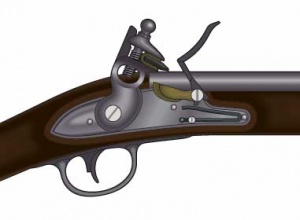Frizzen and Flint
Perhaps the most common faux pas we make when talking with the public about our weapons is in calling the cock a hammer and the hammer a "frizzen". The cock apparently got its name from its resemblance to a pecking rooster, and only became known as a "hammer" much later in the percussion-cap era. As for the term "frizzen," there simply was no such word in the 18th-century � in fact I could not find "frizzen" listed in ANY dictionary, new or old, including the huge, multi-volume Oxford Dictionary of the English Language. The best guess I have heard so far is that this anachronistic term dates from the late 19th or early 20th-century and is a corruption of the Dutch or Germanic word "frizzel" or "furison", both of which were apparently first used to described the hammer of a flintlock in 1892.
"Frizzen cover" is also an anachronism. Both Simes and Cuthbertson talk of "hammer stalls," being used as a safety device, but there is no mention of frizzens or frizzen covers in either text. The hammer can also be referred to as a "steel," but should never be called a frizzen.
